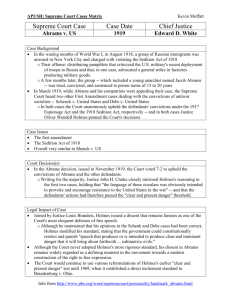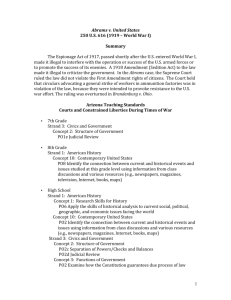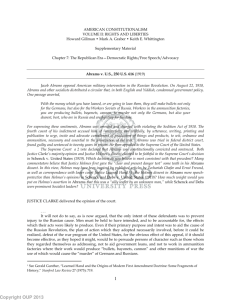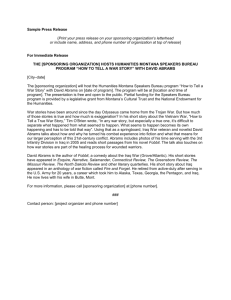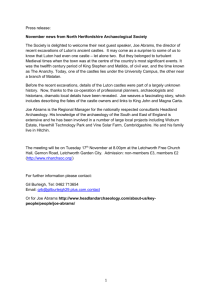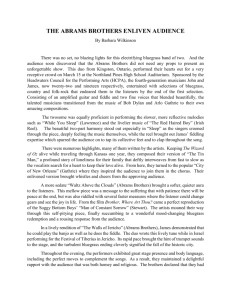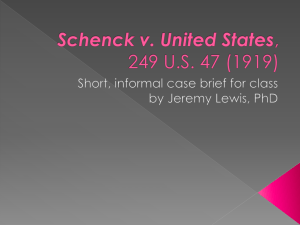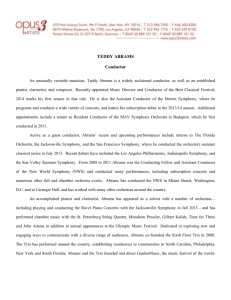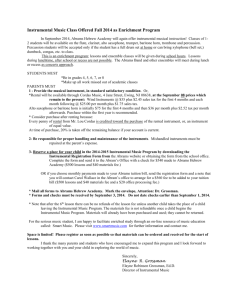U.S. Supreme Court, Abrams v. United States (1919)
advertisement
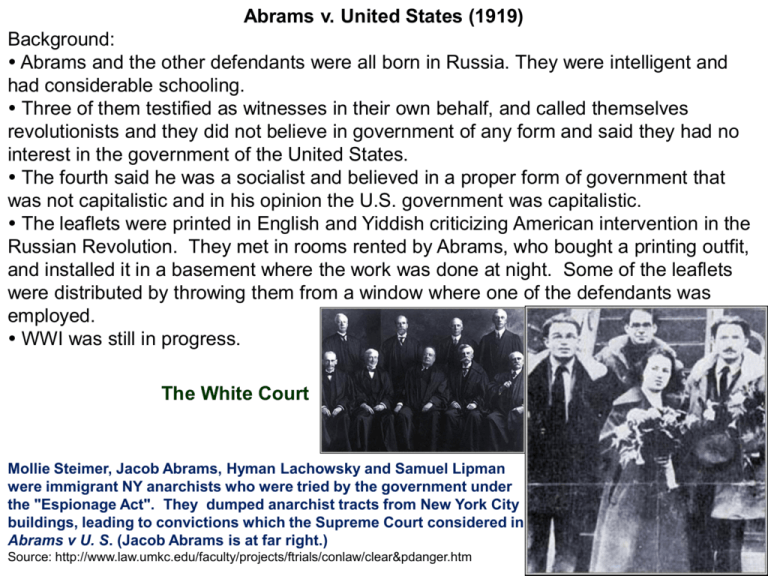
Abrams v. United States (1919) Background: Abrams and the other defendants were all born in Russia. They were intelligent and had considerable schooling. Three of them testified as witnesses in their own behalf, and called themselves revolutionists and they did not believe in government of any form and said they had no interest in the government of the United States. The fourth said he was a socialist and believed in a proper form of government that was not capitalistic and in his opinion the U.S. government was capitalistic. The leaflets were printed in English and Yiddish criticizing American intervention in the Russian Revolution. They met in rooms rented by Abrams, who bought a printing outfit, and installed it in a basement where the work was done at night. Some of the leaflets were distributed by throwing them from a window where one of the defendants was employed. WWI was still in progress. The White Court Mollie Steimer, Jacob Abrams, Hyman Lachowsky and Samuel Lipman were immigrant NY anarchists who were tried by the government under the "Espionage Act". They dumped anarchist tracts from New York City buildings, leading to convictions which the Supreme Court considered in Abrams v U. S. (Jacob Abrams is at far right.) Source: http://www.law.umkc.edu/faculty/projects/ftrials/conlaw/clear&pdanger.htm Main Points: Abrams and his colleagues were charged on 4 counts of conspiring: 1) “disloyal and abusive language about the form of Government of the United States” 2) the language “intended to bring the form of Government of the United States into contempt” 3) the language "intended to incite, provoke, and encourage resistance to the United States in said war” 4) “when the United States was at war with the Imperial German Government…unlawfully and willfully ... to urge, incite and advocate curtailment of production of…ordnance and ammunition, necessary and essential to the prosecution of the war” Although it was argued that the Espionage Act was unconstitutional and in conflict with the First Amendment, it was argued briefly and proven otherwise: On the record thus described it is argued, somewhat faintly, that the acts charged against the defendants were not unlawful because within the protection of that freedom of speech and of the press which is guaranteed by the First Amendment to the Constitution of the United States, and that the entire Espionage Act is unconstitutional because in conflict with that Amendment. This contention is sufficiently discussed and is definitely negative in Schenck v. United States. Main Points: According to Holmes there was not enough evidence to promote danger or hinder the success of the government: “Now nobody can suppose that the surreptitious publishing of a silly leaflet by an unknown man, without more, would present any immediate danger that its opinions would hinder the success of the government arms or have any appreciable tendency to do so.” They were found guilty by the original court: “by bringing upon the country the paralysis of a general strike, thereby arresting the production of all munitions and other things essential to the conduct of war...Thus ...the defendants were guilty as charged...and...the judgment of the District Court must be Affirmed.” If in the event the threat poses no “clear and present danger,” the best place to dismiss dangerous or disagreeable ideas is in the market place of ideas. Persuasion is more persistent than imprisoning people with dangerous and disagreeable ideas. “But when men have realized that time has upset many fighting faiths, they may come to believe even more than they believe the very foundations of their own conduct that the ultimate good desired is better reached by free trade in ideas – that the best test of truth is the power of the thought to get itself accepted in the competition of the market, and that truth is the only ground upon, which their wishes safely can be carried out.” Historical Significance • Abrams v. United States was during the time while America intervening into the Russian Revolution • The case involved the 1918 amendment to the Espionage Act of 1917 which made it a criminal offense to criticize the U.S. Federal Government. • The case was overturned during the Vietnam War Era in Brandenburg v. Ohio. The decision was based on Holmes’ argument of “clear and present danger” Abrams v. United States • Work taken from the United States Reports of the U.S. Supreme Court • Argued October 21-22, 1919 • Decided November 10, 1919 Court Membership • Chief Justice was Edward Douglass White. • Associate Justices: Joseph McKenna, Oliver Holmes, William Day, Willis Van Devanter, Mahlon Pitney, James McReynolds, Lois Brandeis, and John Hessin Clarke • Case opinions: Majority by Clarke and Dissent by Holmes Defendants • Jacob Abrams and four colleagues were convicted of conspiring to violate the Espionage Act. Main Points According to Mr. Justice Clarke and the opinion of the courts, Abrams and others advocated a strike in munitions production and the violent overthrow of the Government. – “Courts charge the defendants with conspiring to unlawfully utter, print, write and publish abusive language about the form of government of the United States.” – “The manifest purpose of such a publication was to create an attempt to defeat the war plans of the government, by bringing upon the country the paralysis of a general strike, thereby resting production of munitions and other things essential to the conduct of war.” Main Points The points of Mr. Justice Holmes dissenting, Abrams and others should not be viewed as criminals due to their writings – “Advocacy of a general strike do urge curtailment of production of things necessary to the prosecution of the war within the meaning of the Act of 1917. But to make the conduct criminal that statute requires that it should be with intent by such curtailment to cripple or hinder the United States in the persecution of the war.” The first amendment should protect Abrams freedom of speech – “ I refer to the First Amendment to the Constitution that Congress shall make no law abridging the freedom or speech.” Main Points Congress cannot forbid all effort to change the mind of the country. – “ The principle of the right to free speech is always the same. It is only the present danger or immediate evil or an intent to bring it about that warrants Congress in setting a limit to the expression of opinion where private rights are not concerned.” • The truth has to be accepted within the competition of the market. – “The best test of truth is the power of the thought to get itself accepted in the competition of the market, and that truth is the only ground upon which their wishes safely can be carried out.” Historical Significance • Abrams v. United States was during the time while America intervening into the Russian Revolution • The case involved the 1918 amendment to the Espionage Act of 1917 which made it a criminal offense to criticize the U.S. Federal Government. • The case was overturned during the Vietnam War Era in Brandenburg v. Ohio • Based on Holmes argument of “clear and present danger” Questions to Consider?? • If we can agree that what Abrams advocates in his pamphlet is wrong, how can we most effectively discredit his argument? • When does one cross the line between freedom of speech and immediate danger or evil intent?
